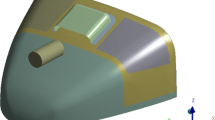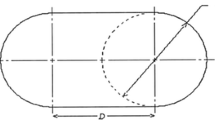Abstract
In a bird strike, the bird undergoes large deformation like flows; while most part of the structure is in small deformation, the region near the impact point may experience large deformations, even fail. This paper develops a coupled shell-material point method (CSMPM) for bird strike simulation, in which the bird is modeled by the material point method (MPM) and the aircraft structure is modeled by the Belytschko–Lin–Tsay shell element. The interaction between the bird and the structure is handled by a particle-to-surface contact algorithm. The distorted and failed shell elements will be eroded if a certain criterion is reached. The proposed CSMPM takes full advantages of both the finite element method and the MPM for bird strike simulation and is validated by several numerical examples.
















Similar content being viewed by others
References
Heimbs S. Computational methods for bird strike simulations: a review. Comput Struct. 2011;89(23–24):2093–112.
Hedayati R, Sadighi M, Mohammadi-aghdam M. On the difference of pressure readings from the numerical, experimental and theoretical results in different bird strike studies. Aerosp Sci Technol. 2014;32(1):260–6.
Hedayati R, Sadighi M. Bird strike: an experimental, theoretical and numerical investigation. Amsterdam: Elsevier Science; 2015.
Dolbeer RA, Wright SE, Weller JR, Anderson AL, Begier MJ. Wildlife strikes to civil aircraft in the united states 1990–2014. FAA/USDA: Tech. rep; 2015.
Wilbeck JS. Impact behavior of low strength projectiles. Wright-Patterson Air Force Base: Tech. rep; 1978.
Georgiadis S, Gunnion AJ, Thomson RS, Cartwright BK. Bird-strike simulation for certification of the boeing 787 composite moveable trailing edge. Compos Struct. 2008;86(1–3):258–68.
Anghileri M, Castelletti L-ML, Mazza V. Birdstrike: approaches to the analysis of impacts with penetration. Impact Load Lightweight Struct. 2005;49:63–74.
Lavoie M-A, Gakwaya A, Nejad Ensan M, Zimcik D. Validation of available approaches for numerical bird strike modeling tools. Int Rev Mech Eng. 2007;1(4):380–9.
Sulsky D, Chen Z, Schreyer HL. A particle method for history-dependent materials. Comput Methods Appl Mech Eng. 1994;118(1–2):179–96.
Sulsky D, Zhou S-J, Schreyer HL. Application of a particle-in-cell method to solid mechanics. Comput Phys Commun. 1995;87(1–2):236–52.
Lian YP, Zhang X, Liu Y. An adaptive finite element material point method and its application in extreme deformation problems. Comput Methods Appl Mech Eng. 2012;241–244(1):275–85.
Lian YP, Liu Y, Zhang X. Coupling of membrane element with material point method for fluid–membrane interaction problems. Int J Mech Mater Des. 2014;10(2):199–211.
Ma S, Zhang X, Qiu XM. Comparison study of MPM and SPH in modeling hypervelocity impact problems. Int J Impact Eng. 2009;36:272–82.
Lian YP, Zhang F, Liu Y, Zhang X. Material point method and its applications. Adv Mech. 2013;43(2):237–64.
Lian YP, Zhang X, Zhou X, Ma S, Zhao YL. Numerical simulation of explosively driven metal by material point method. Int J Impact Eng. 2011;38:237–45.
Andersen S, Andersen L. Modelling of landslides with the material-point method. Comput Geosci. 2010;14:137–47.
Nairn JA. Material point method calculations with explicit cracks. CMES-Comput Model Eng Sci. 2003;4:649–63.
Zhang DZ, Zou Q, VanderHeyden WB, Ma X. Material point method applied to multiphase flows. J Comput Phys. 2008;227:3159–73.
Zhang X, Sze KY, Ma S. An explicit material point finite element method for hyper velocity impact. Int J Numer Meth Eng. 2006;66:689–706.
Lian YP, Zhang X, Zhou X, Ma ZT. A FEMP method and its application in modeling dynamic response of reinforced concrete subjected to impact loading. Comput Methods Appl Mech Eng. 2011;200(17–20):1659–70.
Lian YP, Zhang X, Liu Y. Coupling of finite element method with material point method by local multi-mesh contact method. Comput Methods Appl Mech Eng. 2011;200:3482–94.
Chen ZP, Qiu XM, Zhang X, Lian YP. Improved coupling of finite element method with material point method based on a particle-to-surface contact algorithm. Comput Methods Appl Mech Eng. 2015;293:1–19.
Belytschko T, Lin JI, Chen-Shyh T. Explicit algorithms for the nonlinear dynamics of shells. Comput Methods Appl Mech Eng. 1984;42(2):225–51.
Hallquist JO. ANSYS/LS-DYNA Theoretical Manual, Livermore Software Technology Corporation, 2006.
ESI Group, Theory Notes Manual, PAM System International, Paris, France, 2000.
Dassault Systèmes, ABAQUS 6.12 Theory manual, Dassault Systèmes, Paris, France, 2012.
Belytschko T, Wong BL, Chiang H-Y. Advances in one-point quadrature shell elements. Comput Methods Appl Mech Eng. 1992;96(1):93–107.
Mindlin RD. Influence of rotary inertia and shear on flexural motions of isotropic, elastic plates. J Appl Mech. 1951;18:31–8.
Flanagan DP, Belytschko T. A uniform strain hexahedron and quadrilateral with orthogonal hourglass control. Int J Numer Meth Eng. 1981;17(5):679–706.
Belytschko T, Lin JI. A three-dimensional impact-penetration algorithm with erosion. Comput Struct. 1987;25(1):95–104.
Ma Z, Zhang X, Huang P. An object-oriented MPM framework for simulation of large deformation and contact of numerous grains. CMES-Comput Model Eng Sci. 2010;55(1):61–87.
Zhang X, Lian YP, Liu Y, Xu Z. The Material Point Method. Beijing: Tsinghua University Press; 2013 (in Chinese).
McCarthy MA, Xiao JR, McCarthy CT, Kamoulakos A, Ramos J, Gallard JP, Melito V. Modelling of bird strike on an aircraft wing leading edge made from fibre metal laminates—part 2: modelling of impact with sph bird model. Appl Compos Mater. 2004;11(5):317–40.
Hedayati R, Ziaei-Rad S. Foam-core effect on the integrity of tailplane leading edge during bird-strike event. J Aircr. 2011;48(6):2080–9.
Langrand B, Bayart A-S, Chauveau Y, Deletombe E. Assessment of multi-physics FE methods for bird strike modelling-application to a metallic riveted airframe. Int J Crashworthiness. 2002;7(4):415–28.
Hanssen AG, Girard Y, Olovsson L, Berstad T, Langseth M. A numerical model for bird strike of aluminium foam-based sandwich panels. Int J Impact Eng. 2006;32(7):1127–44.
Sun Q, Liu YJ, Jin RH. Numerical simulation of bird strike in aircraft leading edge structure using a new dynamic failure model. In: International Council of the Aeronautical Sciences, 2014.
Swegle J, Hicks D, Attaway S. Smoothed particle hydrodynamics stability analysis. J Comput Phys. 1995;116(1):123–34.
Author information
Authors and Affiliations
Corresponding author
Additional information
Supported by the National Natural Science Foundation of China (11390363).
Rights and permissions
About this article
Cite this article
Wu, B., Chen, Z., Zhang, X. et al. Coupled Shell-Material Point Method for Bird Strike Simulation. Acta Mech. Solida Sin. 31, 1–18 (2018). https://doi.org/10.1007/s10338-018-0001-2
Received:
Revised:
Accepted:
Published:
Issue Date:
DOI: https://doi.org/10.1007/s10338-018-0001-2




